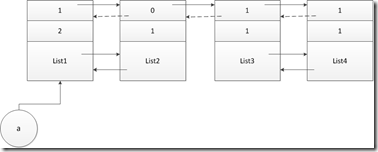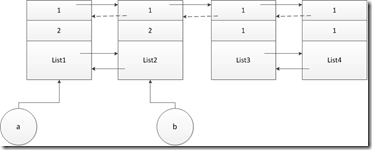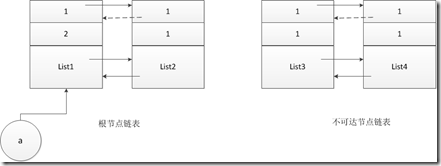这篇算是一个完整的收集流程:链表建立,确定根节点,垃圾标记,垃圾回收~
1、链表建立
首先,中里在分代技术说过:0代触发将清理所有三代,1代触发会清理1,2代,2代触发后只会清理自己。在清理0代时,会将三个链表(代)链接起来,清理1代的时,会链接1,2两代。在后面三步,都是针对的这个建立之后的链表。
2、确定根节点
图1为一个例子。list1与list2循环引用,list3与list4循环引用。a是一个外部引用。
图1
对于这样一个链表,我们如何得出根节点呢。python里是在引用计数的基础上又提出一个有效引用计数的概念。顾名思义,有效引用计数就是去除循环引用后的计数。
下面是计算有效引用计数的相关代码:
/* Set all gc_refs = ob_refcnt. After this, gc_refs is > 0 for all objects
* in containers, and is GC_REACHABLE for all tracked gc objects not in
* containers.
*/
static void
update_refs(PyGC_Head *containers)
{
PyGC_Head *gc = containers->gc.gc_next;
for (; gc != containers; gc = gc->gc.gc_next) {
assert(gc->gc.gc_refs == GC_REACHABLE);
gc->gc.gc_refs = Py_REFCNT(FROM_GC(gc));
assert(gc->gc.gc_refs != 0);
}
}
/* A traversal callback for subtract_refs. */
static int
visit_decref(PyObject *op, void *data)
{
assert(op != NULL);
if (PyObject_IS_GC(op)) {
PyGC_Head *gc = AS_GC(op);
/* We're only interested in gc_refs for objects in the
* generation being collected, which can be recognized
* because only they have positive gc_refs.
*/
assert(gc->gc.gc_refs != 0); /* else refcount was too small */
if (gc->gc.gc_refs > 0)
gc->gc.gc_refs--;
}
return 0;
}
/* Subtract internal references from gc_refs. After this, gc_refs is >= 0
* for all objects in containers, and is GC_REACHABLE for all tracked gc
* objects not in containers. The ones with gc_refs > 0 are directly
* reachable from outside containers, and so can't be collected.
*/
static void
subtract_refs(PyGC_Head *containers)
{
traverseproc traverse;
PyGC_Head *gc = containers->gc.gc_next;
for (; gc != containers; gc=gc->gc.gc_next) {
traverse = Py_TYPE(FROM_GC(gc))->tp_traverse;
(void) traverse(FROM_GC(gc),
(visitproc)visit_decref,
NULL);
}
}update_refs函数里建立了一个引用的副本。
visit_decref函数对引用的副本减1,subtract_refs函数里traverse的作用是遍历对象里的每一个引用,执行visit_decref操作。
最后,链表内引用计数副本非0的对象,就是根节点了。
说明:
1、为什么要建立引用副本?
答:这个过程是寻找根节点的过程,在这个时候修改计数不合适。subtract_refs会对对象的引用对象执行visit_decref操作。如果链表内对象引用了链表外对象,那么链表外对象计数会减1,显然,很有可能这个对象会被回收,而回收机制里根本不应该对非回收对象处理。
2、traverse的疑问(未解决)?
答:一开始,有个疑问。上面例子里,subtract_refs函数中处理完list1结果应该如下:
然后gc指向list2,此时list2的副本(为0)不会减少,但是list2对list1还是存在实际上的引用,那么list1副本会减1吗?显然,如果减1就出问题了。
所以list1为0时,traverse根本不会再去处理list1这些引用(或者说,list2对list1名义上不存在引用了)。
此时,又有一个问题,如果存在一个外部对象b,对list2引用,subtract_refs函数中处理完list1后,如下图:
当subtract_refs函数中遍历到list2时,list2的副本还会减1吗?显然traverse的作用还是没有理解。
3、垃圾标记
接下来,python建立两条链表,一条存放根节点,以及根节点的引用对象。另外一条存放unreachable对象。
标记的方法就是中里的标记思路,代码如下:
/* A traversal callback for move_unreachable. */
static int
visit_reachable(PyObject *op, PyGC_Head *reachable)
{
if (PyObject_IS_GC(op)) {
PyGC_Head *gc = AS_GC(op);
const Py_ssize_t gc_refs = gc->gc.gc_refs;
if (gc_refs == 0) {
/* This is in move_unreachable's 'young' list, but
* the traversal hasn't yet gotten to it. All
* we need to do is tell move_unreachable that it's
* reachable.
*/
gc->gc.gc_refs = 1;
}
else if (gc_refs == GC_TENTATIVELY_UNREACHABLE) {
/* This had gc_refs = 0 when move_unreachable got
* to it, but turns out it's reachable after all.
* Move it back to move_unreachable's 'young' list,
* and move_unreachable will eventually get to it
* again.
*/
gc_list_move(gc, reachable);
gc->gc.gc_refs = 1;
}
/* Else there's nothing to do.
* If gc_refs > 0, it must be in move_unreachable's 'young'
* list, and move_unreachable will eventually get to it.
* If gc_refs == GC_REACHABLE, it's either in some other
* generation so we don't care about it, or move_unreachable
* already dealt with it.
* If gc_refs == GC_UNTRACKED, it must be ignored.
*/
else {
assert(gc_refs > 0
|| gc_refs == GC_REACHABLE
|| gc_refs == GC_UNTRACKED);
}
}
return 0;
}
/* Move the unreachable objects from young to unreachable. After this,
* all objects in young have gc_refs = GC_REACHABLE, and all objects in
* unreachable have gc_refs = GC_TENTATIVELY_UNREACHABLE. All tracked
* gc objects not in young or unreachable still have gc_refs = GC_REACHABLE.
* All objects in young after this are directly or indirectly reachable
* from outside the original young; and all objects in unreachable are
* not.
*/
static void
move_unreachable(PyGC_Head *young, PyGC_Head *unreachable)
{
PyGC_Head *gc = young->gc.gc_next;
/* Invariants: all objects "to the left" of us in young have gc_refs
* = GC_REACHABLE, and are indeed reachable (directly or indirectly)
* from outside the young list as it was at entry. All other objects
* from the original young "to the left" of us are in unreachable now,
* and have gc_refs = GC_TENTATIVELY_UNREACHABLE. All objects to the
* left of us in 'young' now have been scanned, and no objects here
* or to the right have been scanned yet.
*/
while (gc != young) {
PyGC_Head *next;
if (gc->gc.gc_refs) {
/* gc is definitely reachable from outside the
* original 'young'. Mark it as such, and traverse
* its pointers to find any other objects that may
* be directly reachable from it. Note that the
* call to tp_traverse may append objects to young,
* so we have to wait until it returns to determine
* the next object to visit.
*/
PyObject *op = FROM_GC(gc);
traverseproc traverse = Py_TYPE(op)->tp_traverse;
assert(gc->gc.gc_refs > 0);
gc->gc.gc_refs = GC_REACHABLE;
(void) traverse(op,
(visitproc)visit_reachable,
(void *)young);
next = gc->gc.gc_next;
}
else {
/* This *may* be unreachable. To make progress,
* assume it is. gc isn't directly reachable from
* any object we've already traversed, but may be
* reachable from an object we haven't gotten to yet.
* visit_reachable will eventually move gc back into
* young if that's so, and we'll see it again.
*/
next = gc->gc.gc_next;
gc_list_move(gc, unreachable);
gc->gc.gc_refs = GC_TENTATIVELY_UNREACHABLE;
}
gc = next;
}
}标记之后,链表如上图。
4、垃圾回收
回收的过程,就是销毁不可达链表内对象。下面代码就是list的清除方法:
/* Methods */
static void
list_dealloc(PyListObject *op)
{
Py_ssize_t i;
PyObject_GC_UnTrack(op);
Py_TRASHCAN_SAFE_BEGIN(op)
if (op->ob_item != NULL) {
/* Do it backwards, for Christian Tismer.
There's a simple test case where somehow this reduces
thrashing when a *very* large list is created and
immediately deleted. */
i = Py_SIZE(op);
while (--i >= 0) {
Py_XDECREF(op->ob_item[i]);
}
PyMem_FREE(op->ob_item);
}
if (numfree < PyList_MAXFREELIST && PyList_CheckExact(op))
free_list[numfree++] = op;
else
Py_TYPE(op)->tp_free((PyObject *)op);
Py_TRASHCAN_SAFE_END(op)
}
























 1331
1331

 被折叠的 条评论
为什么被折叠?
被折叠的 条评论
为什么被折叠?








